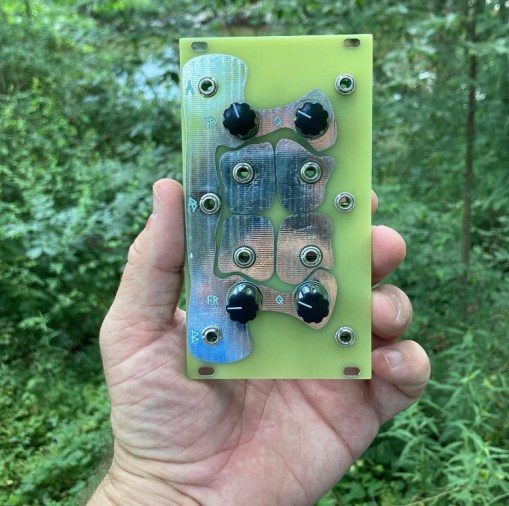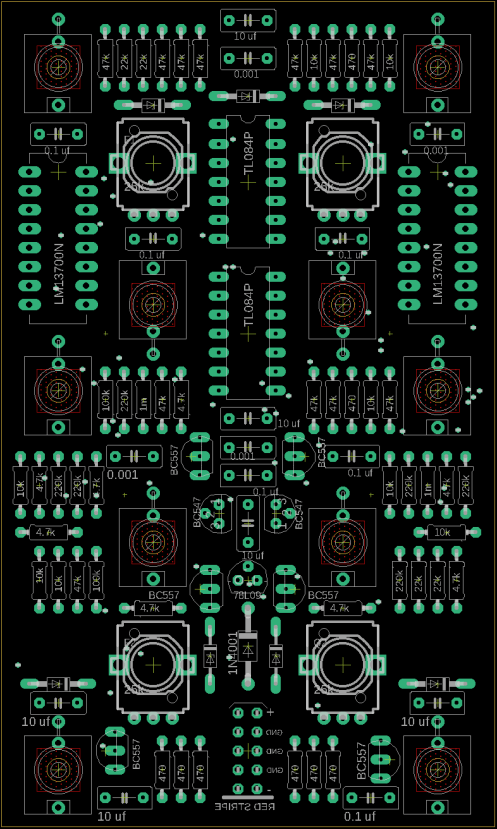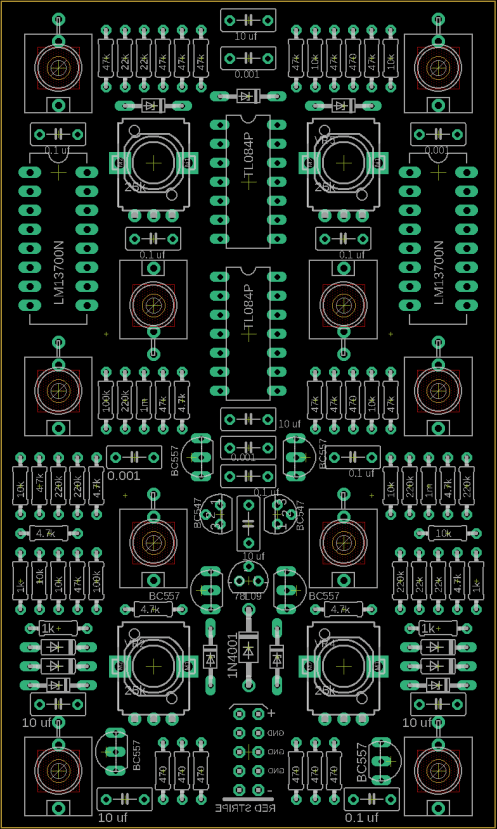Duber

Another DIY hit from the house of Vaux… or is it? I mean, is it? It sure doesn’t look like something we’d craft – case in point, where’s the abstract vector graffiti? What about the incomprehensible text? And I thought most of our wares were named after some sort of odd pun in Spanish that only about three people get without extensive explanation, literary references and the acknowledgment that in the long run it really wasn’t that funny to begin with. Yup – none of that’s here.
So what gives? Two things, I suppose. First up, this is a collaboration with Wisconsin synth wizard CrucFX, created over our shared love and inspiration taken from the wares of one Pete Blasser. Second, speaking of said Blasser character, this particular creature is a Eurorack port of his nigh-legendary Duber filter, as rendered in IFM style and consisting entirely of commonly-found, through-hole parts for anyone looking to either expand their IFM-themed racks, or save themselves some space in their kit while traveling, possibly with the added advantage of not having to explain what the rough-hewn wooden box with the spikes driven into it is to your friendly neighborhood security agent.
To further elaborate for those still reading and possibly without a clue about acronyms and name-checking, here’s your technical readout: It’s a dual (resonant) bandpass filter, hence the names. Du, as in dual, B as in bandpass, Er, as in filter. I’m sure someone well-versed in the lore of Peter B will undoubtedly tell me about some illustrated dream he had, or how it’s linked to the sound of ancient cave bears or something, but hey, for a mnemonic, it works. On the input, you have three choices via any combination of filter 1, 2 or s summed mix of 1 and 2. Each filter has the usual center frequency and resonance controls and the output has the same choices as the input. There’s also 4 CV inputs that can be pinged to begin animating the filters in some pretty funky ways. All said, it’s a pretty crunchy beast, not to mention unique. It’s definitely not for everyone, but for those interested in taking the plunge, it’ll definitely serve as a decent lab for exploration for a good second. Oh yeah, did we mention that there’s touch points on it as well? Because there totally is.
Also also, as it happens, this beast is totally DIY. If you want one, you’re gonna have to build it yourself. Or have a friend build it. Or buy one from a friend of a friend for an optimal, not-for-profit rate. At least on my end, I won’t be selling kits or leading workshops or anything like that – this is a straight labor of love as far as I’m concerned. If you’re looking for the quick and easy, CrucFX does have a slightly skinnier rendition of the same circuit on the vend and I’m sure he’d love your business, but in my hood, I’m providing only some files and advice free of charge.
Business Stuff
I’m largely keeping this section here for consistency – not to mention for those who like to cut the fat and dive right into logistics but for those that didn’t read the intro, this critter’s DIY only. Like it? Build it!
Media
Clip one – using an EuRolz to ping a Tides and Plaits, which is then run into the Duber sans CV. Crunchy and quacky!
Clip two – things you can do with a Benjolin and this critter.
Additional Info
- Power is provided by the usual ribbon cable – red stripe positioned as marked on the panel. As a heads up, a shrouded headers are too big for this one so be careful and always check before you hit that switch. In theory there’s reverse power protection in place, but even so. Speaking of power draw is fairly minimal – probably less than 100 ma, and only on the positive side of the cable.
- As with all DIY audio electronics that have exposed circuitry, I am in no way am responsible for electrocution, injury, loss of life, etc. due to misuse of this product, act of angry deity, etc. I trust that you’ll do the right thing in the end and not do something foolish like lick this or perform in the bathtub or something, but hey, gotta cover my backside.
- Depth is minimal – like maybe 16 mm or so. In other words, “skiff friendly.”
- Width is 14 hp. Kinda chunky, but whatevs, it uses a lot of parts, I wanted to keep it on a single board and its ergonomic.
BOM
Diodes
- 1x 1n4001
- 7x 1n5239
Resistors
- 8x 470r
- 8x 4.7k
- 8x 10k
- 4x 22k
- 12x 47k
- 2x 100k
- 6x 220k
- 2x 1m
Capacitors
- 4x 0.001 uf
- 6x 0.1 uf
- 6x 10 uf (multilayer ceramic)
Transistors
- 2x bc547
- 6x bc557
IC’s
- 2x lm13700
- 2x tl084 (74’s will also work)
Misc
- 10x “Thonkicon” style 3.5mm jacks
- 1x 78l09 voltage regulator
- 1x 2×5 power header (unshrouded)
- 4x 25k linear potentiometers
Download
Eagle and Gerber files can be found here.
Layout
Here’s a decent snap of the board layout for those in need of magnification or don’t have a copy of Eagle and a 27 inch monitor on their bench to follow along. Keep in mind that this is for the board in the Revision folder on the GitHub – if you have a Version 1 board (basically the same layout, plus a couple extra diodes and resistors, please read on on how to modify your board for some additional CV responsiveness.

Version 1

Ok – so as you’ll notice, the original version has a couple extra parts that the revision doesn’t have. These came by way of differing approaches on how to convert Peter’s original tabletop instrument to a Eurorack one with the least amount of risk of accidentally frying something with an errant bipolar signal. I opted for rectifiers, Josh opted for Zeners an in a fit of over-cautiousness, the final design had both. In retrospect, that was not the correct solution. Yeah, things were safe, in the voltage dept., but did it do stuff? Yeah, not much. That said, if you have this board, or you’ve already built this board and want a little more CV responsiveness, this is what you do:
- Remove all 4 1k resistors and
- Remove all 4 1n4148 diodes and replace with a piece of wire.
And that’s it – instant CV upgrade. Also, as a heads up, the Freq and Q pots are reversed on version 1 – my bad – this was also corrected in the revision. Sorry about that.


